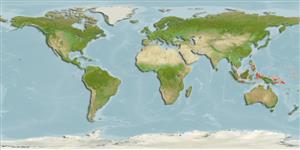Common names from other countries
Пластиножаберные (акулы и скаты) (sharks and rays) >
Orectolobiformes (Carpet sharks) >
Hemiscylliidae (Bamboo sharks)
Etymology: Hemiscyllium: hemi-, from hemisys (Gr.), half, presumably referring to similarity and/ or close affinity to Scyllium (=Scyliorhinus, now in Scyliorhinidae) and/or Chiloscyllium; skylion, Greek for dogfish or small shark. (See ETYFish); galei: In honor of underwater photographer and shark enthusiast Jeffrey Gale, who successfully bid to help conserve this species at a charity auction, and who financially supported Conservation International’s efforts to preserve its habitat. (See ETYFish).
Environment: milieu / climate zone / depth range / distribution range
экология
морской ассоциированный с рифами; пределы глубины 2 - 25 m (Ref. 114942). Tropical
Western Pacific: apparently confined to Cenderawasih Bay, Papua Barat Province, Indonesia.
Size / Вес / Возраст
Maturity: Lm ? range ? - ? cm
Max length : 56.8 cm TL самец/пол неопределен; (Ref. 74956)
Краткое описание
определительные ключи | морфология | морфометрия
This species of bamboo shark is distinguished by its unique combination of white lines/spots along the margin of the large, dark saddles on the back, scattered white spots particularly on the upper side, and a row of 7-8 well-defined, horizontally-ovate, dark spots on the lower side between the abdomen and caudal-fin base (Ref. 74956).
Occurs on shoreline fringing reefs or shallow patch reefs; observed at night at depths of 2-25 m (extreme depth from Ref. 114942), usually seen resting on the bottom, occasionally observed while slowly swimming or 'walking' over the bottom with the pectoral and pelvic fins. Probably sedentary during daylight hours, sheltering under rocky outcrops or tabular corals, typical for other family members (Ref. 74956).
Life cycle and mating behavior
Maturities | размножение | Spawnings | Egg(s) | Fecundities | личинки
Allen, G.R. and M.V. Erdmann, 2008. Two new species of bamboo sharks (Orectolobiformes: hemiscylliidae) from Western New Guinea. aqua, Int. J. Ichthyol. 13(3-4):93-108. (Ref. 74956)
Статус Красного Списка МСОП (Ref. 130435)
CITES (Ref. 128078)
Not Evaluated
Угроза для людей
Harmless
Использование человеком
дополнительная информация
инструменты
Специальные отчеты
Скачать в формате XML
ресурсы в Интернет
Estimates based on models
Preferred temperature (Ref.
115969): 28.1 - 29.2, mean 28.8 (based on 448 cells).
Phylogenetic diversity index (Ref.
82804): PD
50 = 0.5020 [Uniqueness, from 0.5 = low to 2.0 = high].
Bayesian length-weight: a=0.00407 (0.00181 - 0.00918), b=3.09 (2.89 - 3.29), in cm Total Length, based on LWR estimates for this (Sub)family-body shape (Ref.
93245).
Trophic level (Ref.
69278): 3.4 ±0.3 se; based on size and trophs of closest relatives
Fishing Vulnerability (Ref.
59153): Moderate vulnerability (43 of 100).
